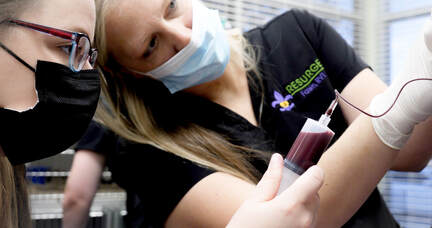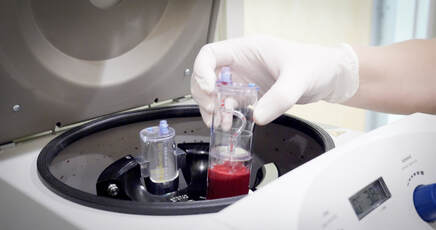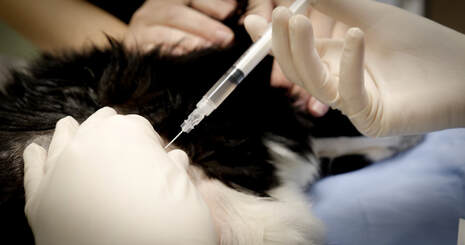Platelet rich plasma (PrP)
Platelet rich plasma, or PRP, is a form of regenerative medicine that is used to help initiate, accelerate and repair injured tissues. It also can be used to decrease inflammatory mediators, reducing pain, and increasing function in patients suffering from osteoarthritis.
The Process
Blood is drawn from the patient and is processed to separate the red blood cells and harvest a concentration of growth factors within the plasma. The plasma is then injected into the patient at the source of the injury or arthritic joint. These growth factors within the PRP activate cells called fibroblasts and endothelial cells to repair wounded and inflamed tissues.
The Process
Blood is drawn from the patient and is processed to separate the red blood cells and harvest a concentration of growth factors within the plasma. The plasma is then injected into the patient at the source of the injury or arthritic joint. These growth factors within the PRP activate cells called fibroblasts and endothelial cells to repair wounded and inflamed tissues.
Common Conditions Treated with PRP
PRP is used to help treat pain from osteoarthritis, and soft tissue injuries (tendon, ligaments, muscle tissue).
Here is a list of common conditions PRP can be used for;
-Hip Dysplasia
-Arthritic pain from CrCL injury (ACL injury)
-iliopsoas injuries
-Shoulder injuries (Biceps Tenosynovitis, Medial Shoulder instability, OCD)
-Elbow Dyslasia (Fragmented Coronoid Process, Ununited Anconeal Process,
PRP is used to help treat pain from osteoarthritis, and soft tissue injuries (tendon, ligaments, muscle tissue).
Here is a list of common conditions PRP can be used for;
-Hip Dysplasia
-Arthritic pain from CrCL injury (ACL injury)
-iliopsoas injuries
-Shoulder injuries (Biceps Tenosynovitis, Medial Shoulder instability, OCD)
-Elbow Dyslasia (Fragmented Coronoid Process, Ununited Anconeal Process,
Combining Hyperbaric Oxygen Therapy with PRP
Hyperbaric oxygen therapy(HBOT) can help bring oxygen to healing tissues making them heal quicker and allow more nutrients to penetrate tissues. Combining both PRP and HBOT creates a
synergy that yields a situation that optimizes repair of an injured area decreasing healing times and enables a quicker return to activity. In short, these combined therapies help the body heal by utilizing its own natural abilities.
Visit our Hyperbaric Oxygen page to learn more about HBOT.
Hyperbaric oxygen therapy(HBOT) can help bring oxygen to healing tissues making them heal quicker and allow more nutrients to penetrate tissues. Combining both PRP and HBOT creates a
synergy that yields a situation that optimizes repair of an injured area decreasing healing times and enables a quicker return to activity. In short, these combined therapies help the body heal by utilizing its own natural abilities.
Visit our Hyperbaric Oxygen page to learn more about HBOT.
Recovery and After Care
Some patients may experience a joint flare, which is a pro inflammatory response to the PRP. A joint flare may appear to make the patient worse but rarely lasts more than about 2 days. Patients receiving PRP need to be off NSAID’s (Non-steriodal anti-inflammatory drugs), but are sent home on other medications to alleviate pain during recovery. PRP recovery is generally 2 weeks. During this time patients should be exercise restricted and be on a leash when brought out to go to the bathroom. This allows the PRP treatment to be optimized and helps keep the patient comfortable during recovery from the procedure.
Some patients may experience a joint flare, which is a pro inflammatory response to the PRP. A joint flare may appear to make the patient worse but rarely lasts more than about 2 days. Patients receiving PRP need to be off NSAID’s (Non-steriodal anti-inflammatory drugs), but are sent home on other medications to alleviate pain during recovery. PRP recovery is generally 2 weeks. During this time patients should be exercise restricted and be on a leash when brought out to go to the bathroom. This allows the PRP treatment to be optimized and helps keep the patient comfortable during recovery from the procedure.






